7 budget GPS guidance systems on test
A decent tractor guidance system is now more affordable than ever and the prospect of die-straight field lines and potentially simpler record-keeping is coaxing in a growing number of lower-acre farmers.
Even those that boast at the pub of their faultless tractor driving might find that one of these systems helps shave a few precious inches off the overlap of each bout across the field. Over the course of a day, that could add up to a couple of acres and several gallons of diesel.
Entry-level GPS kit is also useful for spinning fertiliser on grassland where the lack of tramlines can result in stripey crops, particularly when under the supervision of those livestock boys that see tractor driving as a chore best done as quickly as possible.
You can now land a decent-spec lightbar and display monitor for less than £1,500, a fraction of the cost of pinpoint-accurate top-spec set-ups.
See also: 3 top-selling solar-powered fencers on test
We are talking here about a relatively simple screen that shows your field boundaries, bout lines and can point you in the right direction using a strip of lights or an arrow on the monitor.
At this price you don’t get fancy extras such as automatic steering or sprayer nozzle shut-off, though if you pick your model wisely then there’s a good chance that, for a few quid, you’ll be able to upgrade in the future.
Which one is right for me?
If you simply want to drive straight and make the best use of the width of the machine – and that’s all you can ever see yourself doing – then the cheapest ones will be adequate.
Budget is everything at the most basic level, though it’s still worth taking usability, screen quality and lightbar clarity into account, particularly if your eyesight is poor.
If you’re 100% in this camp, then we would recommend a basic Patchwork box – a simpler one than we had on test – because it’s easy to fathom and comes with a clear screen.
The most important thing to bear in mind is whether you think there is even the smallest possibility that you might want to upgrade in the future. If you do, buying the cheapest won’t pay in the long term – you’re better off shelling out a bit more for a box that has the option of adding more features.
A lot of tractors now come with all the auto-steer gubbins already plumbed in, so upgrading might not be as big a deal as it sounds.
If you are open to the idea of future upgrades and want to do things such as map your fields, record the area you have worked and possibly add in features such as section control at a later date, then there’s no point penny pinching.
If this sounds like you, then we would suggest the Trimble CFX-750.
How accurate are they?
The world of guidance systems is a minefield of acronyms and techy gobbledygook, but here’s (roughly) how it works.
Satellites whizzing around 20,000km away in space calculate your location – the more of them that are able to connect to the receiver in your tractor, the more accurate your location is likely to be. The most you will usually be able to connect to at any one time is 12, but that drops off if you are surrounded by trees or sheds that block the view.
There are two main satellite providers across the world. The first is GPS, an American network of 24 different satellites, and the second is Glonass – the Russian equivalent, with 18 satellites.
However, there are a couple of others currently being established, just in case the Americans or Russians pull the plug on the free access to their networks.
One of the newbies is called Galileo, an initiative involving the EU and European Space Agency. The other is a Chinese network called Beidou.
Buying a receiver that can access GPS and Glonass systems will significantly improve accuracy. However, space-travelling satellites alone can provide accuracy of only 2-5m – nowhere near precise enough for most farming tasks.
Correction signals
To take accuracy levels up a notch, we have to tap in to a service that offers a differential signal provided by ground-based receivers fixed at known locations on Earth. These are able to calculate the real-time position error and fire a correction message back to the satellites.
There are loads of correction signal providers – the less accurate ones are free, while the better ones usually require a yearly subscription.
The best known is Egnos (European Geostationary Navigation Overlay Service), though WAAS (Wide Area Augmentation System) is the American version, so you might come across that, too.
Egnos provides the correction signal for the US GPS system across Europe. It brings pass-to-pass precision to within 30cm, though satellite drift sees year-on-year accuracy slip to 90cm.
It’s free, but is probably best suited to tillage, fertiliser spreading jobs and variable-rate application using lightbar guidance. It can blow hot and cold so isn’t as reliable as the paid-for services.
In a nutshell
There are four pass-to-pass accuracy options based on 15-minute intervals:
- GPS – no differential correction means accuracy is 2-5m
- Differential GPS – correction signal provided by Egnos, with 30cm pass-to-pass accuracy
- High performance – correction signal provided by the likes of Omnistar (subscription) with 10cm pass-to-pass accuracy
- RTK (requires a base station) – either buy your own or pay to access others for 2.5cm accuracy
Omnistar is an example of a more accurate signal. It corrects information provided by GPS and Glonass satellites, but requires an annual subscription of £600 to £1,000.
Pass-to-pass accuracy is within 10cm and year-on-year repeatability is 25cm, so it should be more than capable of jobs including broadacre spraying and drilling using an auto-steer system.
The most accurate option available to farmers is real-time kinetic (RTK). It provides a live correction signal from a single ground reference point – often a base station on the farm or phone mast nearby – to provide 2.5cm accuracy.
The constant ground reference point means it can be repeated time and again without any satellite drift, so it’s perfect for controlled traffic farming systems with fixed tramlines.
The annual cost is similar to Omnistar, but it also requires more expensive hardware.
How we tested them
To make life easier we rigged up a mounting frame to fit in front of the handlebars of a Honda Foreman 450. It meant we had easy access to the battery for wiring-in the boxes and could nip around the fields to record headlands and AB lines without making too much mess.
The main aim of the test was to find out which system is the simplest to set up and use from a first-timer’s point of view. That meant looking closely at how obvious the controls are, the clarity of the screen and lightbar, and whether the price of each one matches its ability.
Although most of them are relatively easy to use, we still found ourselves on the phone to the dealers to get them running as we wanted and with all the functions accessed. We steered clear of testing accuracy of the guidance directly, though we still noticed that the higher-end receivers generally picked up a stronger, more reliable signal.
Ag Leader Compass
£1,695, Precise Solutions
8/10
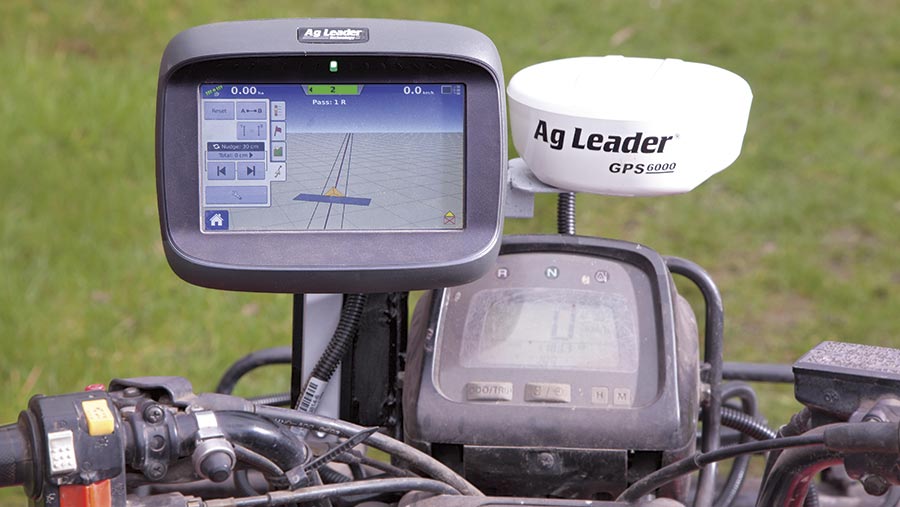
© Jonathan Page
A big, sharp display and bright lightbar put the AgLeader second in our group, though it’s not quite as user-friendly as the Patchwork
Ease of installation
Installation was a messier affair than the Patchwork, with long loops of conduit-wrapped cables and a couple of odd connectors draped around the cab. Power comes from the fag lighter.
The suction cup mount wasn’t strong enough to hold the screen on the window long-term, so bolting it to the cab pillar is your best bet.
It came with a quick set-up guide, which is enough to manage the most basic settings but short of detail for the more complicated mode. In most cases Precise Solutions will set it up beforehand or help with installation – we would recommend taking them up on the offer.
Screen and lightbar quality
The 7in screen is sharp and clear. It shows plenty of useful information, including bout and worked area counters. However, you will need to purchase a £250 linkage switch add-on or auto-steer option for the automatic area counter to work properly, otherwise the area monitor must be turned on or off manually.
The labels and symbols aren’t quite as obvious as the Patchwork or Raven, but the vibrant blue and green lightbar is easy to follow with the corner of your eye.
Ease of use
For those that just want to drive straight and avoid overlaps, the new, basic version of the Compass will do just fine. It’s a doddle to set an AB line without entering bundles of boundary and field info – perfect for contractors spreading fertiliser on grassland who want to drive in a straight line without overlapping, but who won’t be returning to the farm/field again.
If you want to record field names, boundaries and jobs then you have to unlock the advanced mode – it’s free of charge, but you will need to be talked through how to do it.
Recording a boundary is fairly simple, but on each occasion the user must enter an event, which drags out the set-up process.
It is also autosteer and variable rate ready, and comes with a terrain compensation system.
Other models
- InCommand 800 – £2,800. Tablet-style glass touchscreen with built-in wi-fi for downloading maps and the option of upgrading to section control, spreader control and boom height.
- InCommand 1200 – £4,500. Big 12in screen that can show implement controls and guidance at the same time. Comes with auto section shut-off and is the company’s most popular screen.
Upgrade options
- Linkage switch module – £250
- ISO interface to control implements – £500
- Steering wheel motor – £3,800
- AgLeader ECU to operate autosteer-ready tractor – £3,300
Antenna options
- The GPS 6000 receiver comes in the standard Compass package and works off an Egnos signal. For an extra £600 (taking total price to £2,295) you can have the GPS 6500, which also operates with Egnos as standard but can be upgraded to more accurate Terrastar or RTK signals.
Likes
- Clear display
- Big screen
- Easy-to-follow lightbar
Gripes
- Confusing set-up
- No auto area meter
- Less user-friendly than some
Back to the list of guidance systems
Trimble CFX-750 Lite
£1,695, AS Communications
9/10
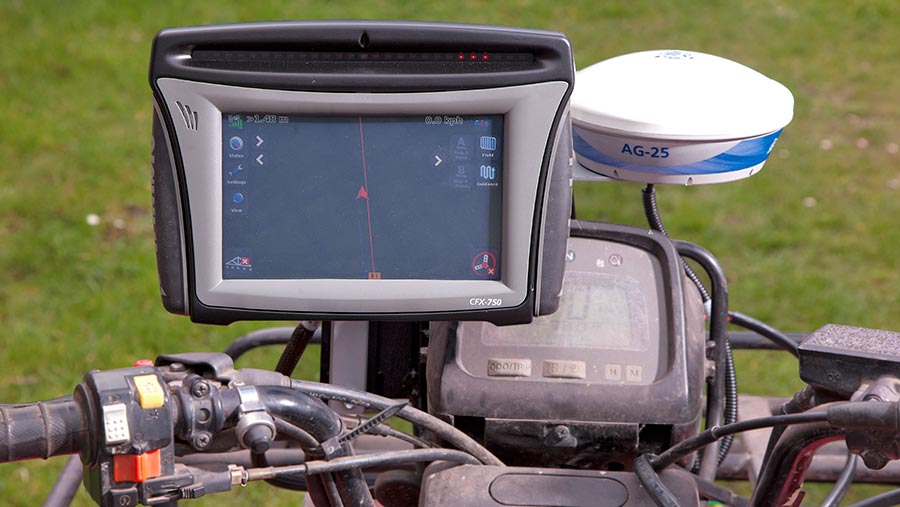
You get what you pay for with the posher Trimble box. The high-res screen and bright lightbar are great for sprayer or spreader section shut-off and it can also store stacks of information
Ease of installation
The big Trimble box is as easy to operate as any of the others, and the instructions include a useful glossary of all the symbols to speed up the learning process.
It needs to be mounted on a solid bracket rather than a suction cup because it’s such a lump, and buyers might also want to replace the ring connectors with a three-pin or fag lighter socket.
Quality of screen and lightbar
The massive screen offers top-notch picture quality and makes it the easiest to follow of the lot, particularly where you are using it to manually control the sprayer or spreader section shut-off.
The lightbar is also good, partly because the width of the screen allows plenty of space for extra LEDs.
Ease of use
The Trimble comes with more functions and options than any of the others, but that doesn’t necessarily translate to extra complication. Once you have got to the bottom of a few of its odd quirks it’s just as easy to drive as the rest.
Operators have to set a farm, field and event each time, but if you are in a hurry you can blitz through the set-up process by just selecting default information.
It’s also possible to select how many headland laps to leave – the only box able to do this – so that you know when to pull the drill out of work. Bout lines appear across the field too, which helps during cultivations.
A comprehensive list of work information appears as a pop-out on the edge of the work screen, but like most of the others it needs a linkage switch or steering system to automatically record area without too many overlaps.
Particularly keen operators can add in heaps of information during set-up, including wind speed, soil conditions, temperature, target pests and product applied, which will be useful for the farm’s spray records. There’s also the option of sending the records straight to the farm office, where they can be downloaded on to software such as Farm Works.
Other models
- EZ Guide 250 – £995
- CFX-750 – £2,395
- TMX – £3,695
Upgrade options
- Linkage switch – £45
- Steering system – £2,700
- Section control – £695
Antenna options
- The CFX-750 Lite comes with the AG25 dome as standard, which will pick up signals from Egnos and the more accurate Omnistar service. It is capable of running on RTK, too.
- Trimble also has its own correction signal called Range Point RTX, which is accurate to 15cm and is free for 12 months. After that, the subscription costs £250+VAT per year but operators can choose to revert to Egnos if they don’t want to spend the money.
Likes
- Massive screen and good graphics
- Very clear lightbar
- Easy to navigate with big buttons and obvious symbols
- Can store loads of information for sound record keeping
Gripes
- Not that clear how to set a boundary
- Too heavy for suction cup – needs a permanent mounting point
- Can’t set a simple AB line without creating an event – hot keys would speed it up
Back to the list of guidance systems
Patchwork Blackbox Go
£1,500, Patchwork Technology
8/10
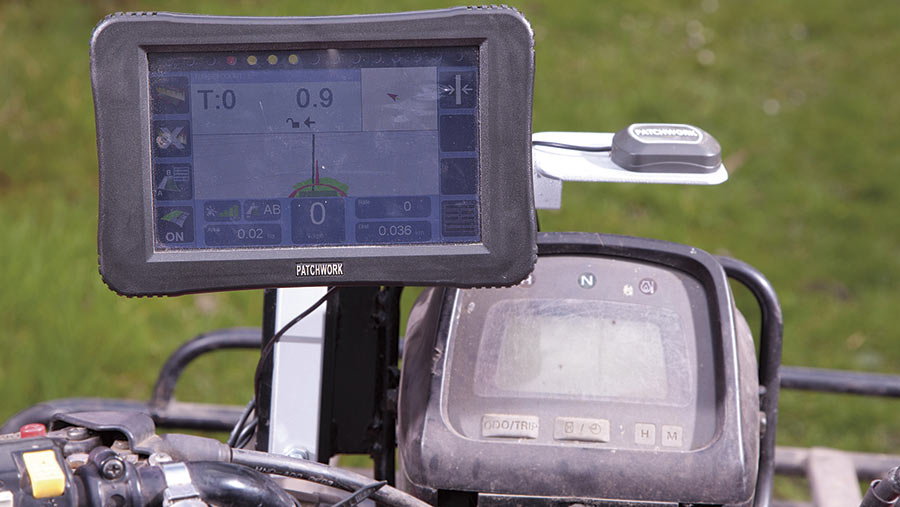
The Patchwork is perfect for anyone new to tractor guidance, and was the easiest to set up and use of all the systems we tried
Ease of installation
Patchwork’s box was the most user-friendly by a distance.
Thin cables from the box to the matchbox-sized antenna are easy to bury in the cab lining and the screenshot-led instruction book is a reliable ally in the set-up process. Even the most reluctant operator will be able to bumble their way to the work screen, filling in all the information along the way.
Quality of screen and lightbar
The rectangular screen is plenty big enough, though the graphics can’t quite match the Ag Leader.
We also found the lightbar was no match for LED-based equivalents, and it was particularly slow in deciding which bout the operator was aiming for after turning on the headland. The blobs that indicate how far you are straying from the line are dim, so you have to stare at the screen continuously if you want to keep on the straight and narrow.
On the bright side, the case is water- and dust-proof, which will give it a better chance of survival when pinned to the handlebars of an ATV.
Ease of use
Operating Patchwork’s system is a piece of cake, even for guidance novices. Big buttons ease the operator through the set-up process in simple, bite-size steps.
A couple of taps of the screen should have the farm and field selected, but fields will also automatically appear as soon as you enter the gateway. Setting an AB line is stress-free, too. You can’t save and re-use old lines, but big buttons make it clear what to press and previously recorded boundaries can be loaded and recycled.
One of the Blackbox’s particular strong points is the area meter. Without plug-in linkage switches, most of the others rely on the driver to manually turn the recorder on and off for accurate area measurement. However, the Patchwork is able to disregard areas that have already been coloured-in on the screen to make the final total far more accurate for field records.
Headland warnings can also be set, and the drill box can be wired-in by Patchwork so that it shuts off at the end of each bout.
However, knowing the precise position of your next run is more difficult to judge, particularly with a wide implement on the back. The screen displays only the current guidance line and can get itself in a pickle as the tractor is directed to the next bout, so there is often a bit of guesswork involved.
Other models
- Eco – £1,000. Simple guidance and measurements, but it doesn’t come with field recognition or a dust-proof case.
- Eco+ – £1,250. Includes field recognition, auto-recording and correction for hills, and can be upgraded from the Eco without changing the hardware.
Upgrade options
- Blackbox Advance – £500 upgrade from the Go, which adds the ability to save previous AB lines and can automatically send field data to farm management software or print maps directly from the memory card. Optional upgrades include variable rate, auto shut-off and section control.
- Evolution – Prices vary depending on the tractor. It adds assisted steering via a mechanical motor on the steering wheel, or auto-steer for tractors with the gubbins already fitted.
Antenna options
- The Go uses GPS with an Egnos correction signal, but other receivers can be fitted to improve in-field accuracy.
Likes
- Very simple to set up and use
- Auto area recording
- Field recognition
Gripes
- Digital lightbar lacks clarity
- Graphics could be sharper
- Bout lines aren’t displayed
Back to the list of guidance systems
Raven Cruizer 2
£1,500, Dempsey Precision
5/10
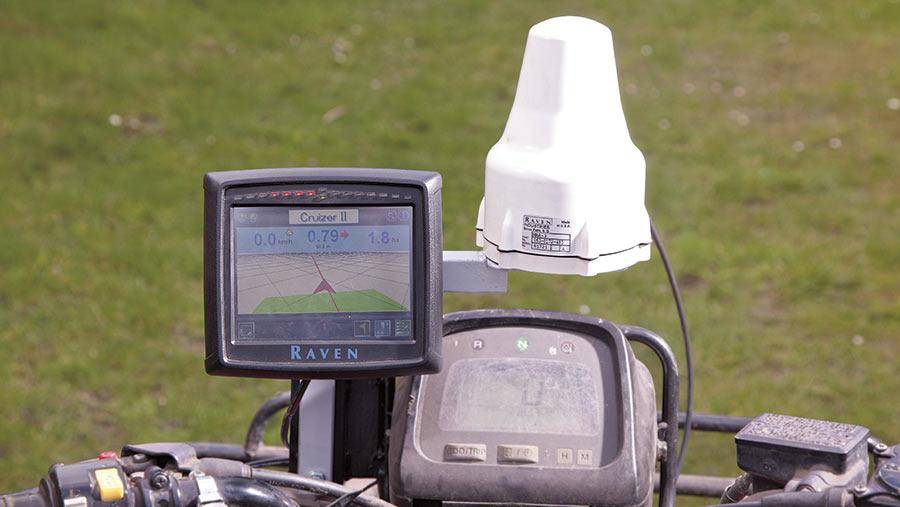
If you are after a basic guidance screen and you want something that’s clear and easy to follow then the Cruizer 2 could be a good bet. However, its slow software really let it down
Ease of installation
The Cruizer was able to rival Patchwork’s box as far as installation was concerned, which makes it easy to chop and change between tractors.
Two thin cables connect the fag lighter and tall dome, although the kit looks less fancy and a bit old compared with some of the others. The supplied instructions are good, which simplifies the set-up process.
Quality of screen and lightbar
The retro square screen and cheap plastic case makes it look lower-end than the Ag Leader, but it is plenty big enough. Screen clarity is also pretty good and the bright LED lightbar was easy to follow too. However, the touchscreen isn’t as sensitive as Trimble’s CFX so typing in information was slightly harder on the move.
Ease of use
It’s a mixed bag here. The big drawback is the painfully slow software – it takes an age to fire up, acquire the satellites and load the run screen. There is no way of avoiding this slowness because you have to select a job or start a new one before you can reach the main screen, which could take close to 10 minutes.
Despite the clunky software, the Raven is actually pretty easy to navigate and the functions of the big buttons are clear without having to stick your nose in the manual.
It takes just a few seconds to set boundaries and straight, curved or pivoted lines, once you have reached the run screen, and it will also remember the boundaries and ABs for each field. However, there is no clever area auto-recording – the driver has to start and stop it manually, unless you buy an extra sensor.
The big problem is that everything other than boundary and AB line settings are found in the spanner section of the screen. It means that for mid-job adjustments – tweaking implement width, for instance – the operator must leave the work display, which takes a couple of minutes.
The company has recently launched a new model that it claims has a far quicker processor.
Other models
- Raven Envizio Pro – £3,995 (Egnos) or £5,975 (RTK). A 6.5in touchscreen that can run off any signal from Egnos to RTK.
- Viper 4+ – £5,250 (Egnos) or £8,250 (RTK). Raven’s fanciest model has a 12.1in touchscreen and comes with section control and variable rate.
Upgrade options
- Weather-resistant version of standard Cruizer 2 – £1,750
- 16-section boom control – £1,050-£1,500
- Cruizer 2 RTK – £3,450
- Auto-steer electric motor – £2,200
Antenna options
- We found the Raven struggled to get a signal in places where most of the others had enough to at least start recording coverage. A patch antenna is available but the signal is not reliable, so the company recommends its white, ice cream cone-style dome to pick up Egnos-corrected guidance.
Likes
- Decent-sized, clear screen
- The basics – AB lines, boundaries – are as simple as anything on test
- Pretty good lightbar
- Big buttons and obvious symbols
Gripes
- Painfully slow software
- Looks and feels old-school
- You have to leave the job to make alterations, which takes ages to reload
Back to the list of guidance systems
Topcon X14
£1,135, Precision Decisions
6/10
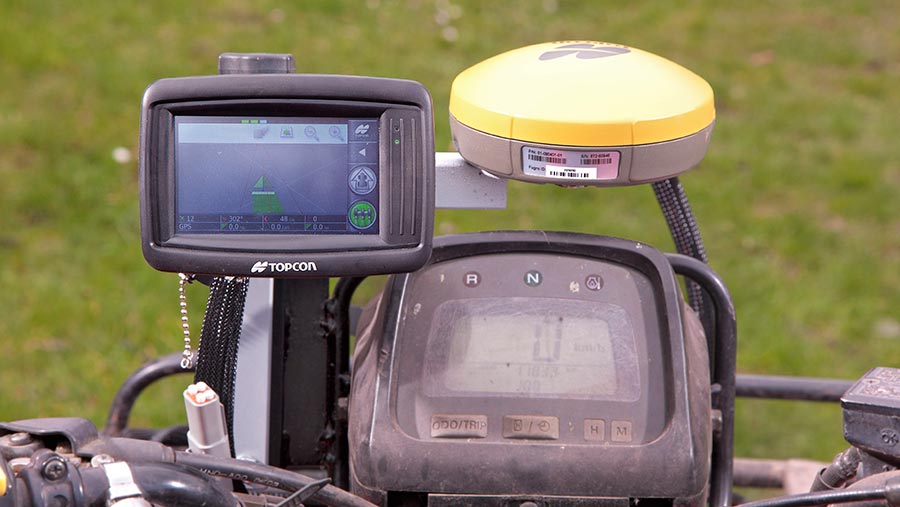
The X14 is a good bit of kit, shoehorned into a small, old-school box. It can’t match some of the others at the budget end of things, but it’s safe to assume that the next model up – the X25 – is the cat’s whiskers
Ease of installation
The Topcon was one of the more untidy installation jobs and the thick cables running from the box to the dome and the power supply were difficult to keep neat.
Quality of screen and lightbar
The X14 comes with a dinky, satnav-sized touchscreen that is difficult to see from a distance, particularly with the glare of the sun shining on it. Like the Patchwork, the Topcon’s digital lightbar is no match for LED-based versions on some of the others.
The screen shows the bouts either side to make life a little easier when it comes to headland turns. Drivers can also change what information is displayed on the home screen, which simplifies navigation.
Ease of use
Operators must agree to the terms and conditions every time it starts up, which is tedious. The instruction book is also imperative because all the functions are hidden behind obscure symbols, rather than words, that take a bit of homework to decipher. Fortunately, the manual was very good.
For each job there is the option of recording information such as weather, wind speed, crop growth stage and variety, which is ideal for detailed crop records and makes it a genuine rival to the big Trimble CFX 750 in all but monitor size.
The screen comes pre-loaded with some tractor models, so if yours is on there already you can select it from the menu rather than having to type it in by hand. There are also preset options to select and set up various different auto steer systems.
Boundary and AB lines can be recorded without having to go through the process of setting up a field or new job. That’s handy if you are not fussed about storing field information, and you can be up and running without trawling through loads of menus within a couple of minutes.
It’s also easy to record individual fields and save both boundaries and AB lines for a later job, while the auto field recognition system makes things easier.
Other models
- X25 – £3,369 (with SGR1 antenna and Egnos guidance). An 8.4in touchscreen built for auto-steer systems and far easier to use than the X14.
- X30 – £6,710 (with AGi4 receiver). Comes with a big 12in touchscreen and works in a similar way to an iPad. Can be split in three to show different work screens, cameras and guidance.
Upgrade options
- Section control – £1,400
- Autosteer – £3,631 (only available with AGi4 receiver)
- Electric steering wheel for the tractor – £2,650
Antenna options and available signals/accuracy
- The SGR1 antenna is standard and offers Egnos guidance for 30cm accuracy. It is possible to fit the more sophisticated AGi4 antenna that can use Omnistar or RTK signals, but it takes the X14’s asking price up to £3,645.
- At that sort of money it makes sense to have the more sophisticated X25 screen, not least because buyers will want an autosteer system for which the X14’s tiny display isn’t really suited.
Likes
- Plenty of functions
- Quick to set boundaries and ABs
- Simple – with the manual by your side
Gripes
- Very small screen
- Can be a faff to find the settings you want, quickly
- Need to know what the symbols mean
Back to the list of guidance systems
Trimble EZ-Guide 250
£995, AS Communications
4/10
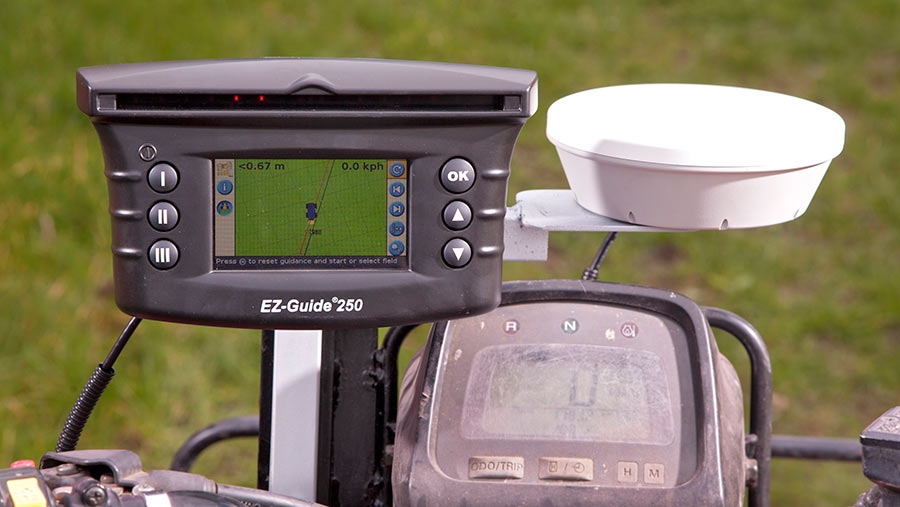
The 250 is beginning to look outdated – for an extra £700 you can have Trimble’s more sophisticated CFX screen, which is far more capable and quicker to use. The lack of a touchscreen is also a shame
Ease of installation
Installation was no bother – the power and antenna cables can be tucked away neatly and the instructions include a handy guide to all the symbols on the screen.
Quality of screen and lightbar
The screen is pretty small for such a big unit and it’s the only non-touchscreen in the ranks, so everything is controlled through chunky rubber buttons. That has major implications on ease of use, particularly when it comes to the clumsy process of typing in field names.
At the top of the screen there is a clear LED lightbar with deep sun visor, which protects the guidance lights from the glare of the sun.
Ease of use
The Trimble offers two operator modes, just like the Ag Leader. We like this arrangement – it means if you simply want to record an AB line and set the implement width then there is no need to input bundles of information.
If you are taking things a bit more seriously then select the “advanced” mode, where you can enter information about clients, farms and fields, and record a boundary. Once a job is completed, it generates a report that can be downloaded, provided you went to the bother of inputting all the information in the first place.
There is a field finder button too, which automatically loads the farm and field information. It will also memorise AB lines for each field for future use, which some of the other boxes won’t, and displays the bout lines either side of the tractor.
The biggest problem with the EZ-Guide 250 is that the screen is too small, which makes it hard to follow and leaves it feeling distinctly old-school, compared with the Ag Leader and Patchwork.
Other models
- CFX 750 Lite – £1,695. The basic version of the larger screen is also featured in this test. It’s a big step up, and definitely worth the extra money. It can also be unlocked for autosteer (which adds £800) and application control (adds £300), and is Glonass unlocked as standard, too.
- CFX 750 full – £2,395. Already enabled for autosteer and application control. Variable rate adds another £685 and higher accuracy starts at £1,650.
Upgrade options
- No upgrade options for the EZ-Guide 250 – what you see is what you get.
Antenna options and available signals/accuracy
- There are two antenna/receiver options. The first is a tiny patch antenna that picks up a standard correction signal and is accurate to about 50cm.
- The second is the big, white Ag15 dome, which operates with an Egnos signal that takes accuracy to 30cm. The Ag15 is £300 more, but is probably worth it in the long run because of the unreliable signal of patch antennas.
Likes
- Separate, shielded LED lightbar
- Lots of instructions/easy to set up
- Has a simple mode – just for an AB line
Gripes
- Small screen
- Clumsy controls
- It’s a big lump
Back to the list of guidance systems
Teejet Matrix 430
£968, Teejet Technologies
3/10
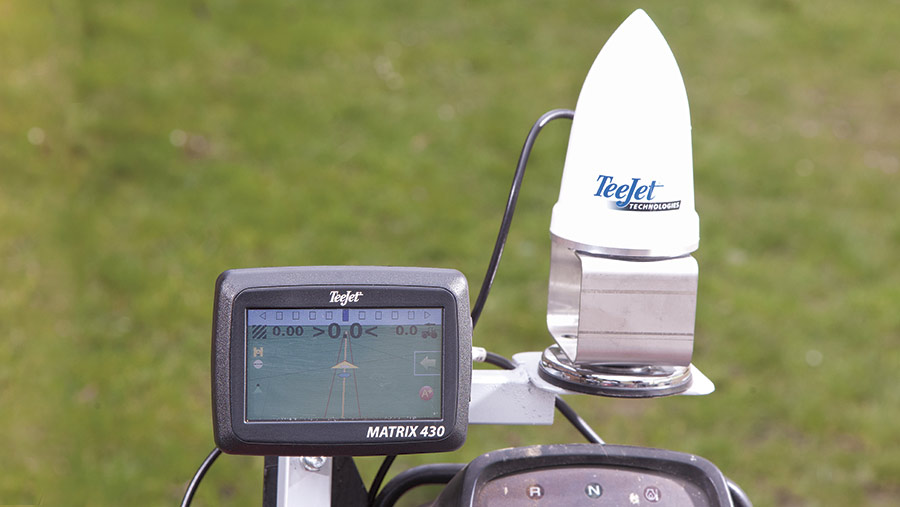
Bargain basement. If an AB line is all you want and you’ve got limited cash to get it, then the Teejet will do. However, for not a whole lot more money you can land something far more advanced, such as the company’s Matrix Pro model
Ease of installation
A small, simple arrangement that feels similar to a car satnav. Flexible cables can be threaded neatly around the tractor cab to the three-pin power supply and curiously-shaped dome on the roof.
Instructions were pretty thin on the ground, which meant it was initially confusing to set AB lines and boundaries even though it’s a far less sophisticated box than the rest.
Quality of screen and lightbar
The screen comes with a pretty poor digital lightbar that has only four stages either side of the centre line – half the number of most of the others.
It is low-res, too, but it’s worth bearing in mind that the Teejet was the cheapest box in our comparison, so if you are shopping on a shoestring it could still fit the bill.
Ease of use
Despite its basic appearance, the Teejet proved quite confusing to operate at first, though things got easier once we learnt where to find the settings.
Other than lightbar spacing, brightness options and a built-in calculator, there’s really very little inside the box. Most of the functions are found by buttons on the work screen and, in fairness, the symbols are more obvious than on the Topcon.
Area coverage is manual only as standard, but can be automated by running a cable to the master switch. Seven-section manual shut-off is also available – the operator just needs to input the size of each section of the sprayer – but implement width can be set only after recording a boundary.
The other downside is the lack of memory – at the end of the job the information needs to be transferred to a USB stick or written down.
However, this box is the most basic that the company offers – if you are willing to part with a few extra shillings then the Matrix Pro will be a genuine contender to some of the more complicated systems included in this test.
Other models
- Matrix Pro GS – £1,520. Brings auto section control, steering, and multiple job recording, reporting and storing. Can run off an RTK signal and comes with a 5.7in or 8.4in screen.
Upgrade options
- External GNSS output and cable for automatic area recording
Antenna options
- The cheapest version comes with a small Patch antenna included in the £968 list price. There’s also the option of speccing the RXA30 antenna, which bumps the bill up to £1,212.
- The more expensive one is no more accurate, but should provide a more reliable service and be less prone to bounced signals. In reality, it probably makes sense to take the cheapest antenna option given the entry-level ability of the Teejet box.
Likes
- Clear screen
- Simple boundary and AB line set-up (once you know how)
- Reasonably priced
Gripes
- Lightbar accuracy
- Small screen
- Work record button too small

